╔
La 37ª Copa América en Barcelona. El efecto dinamizador del evento náutico para el Port Vell
La candidatura de Barcelona como sede de la Copa América de Vela 2024, ha sido un hito destacado en el mundo de los deportes náuticos. En marzo de 2022, Barcelona fue seleccionada como anfitriona de la 37ª edición de la Copa América, un evento de gran prestigio en el mundo de la vela y el deporte en general. Esta elección hizo que Barcelona fuera la primera y única ciudad que ha albergado las tres mayores competiciones deportivas del mundo: un Mundial de Futbol (1982), una Olimpiada (1992) y la Copa América de Vela (2024). Asimismo, la Copa América de Vela es la competición deportiva más antigua en la historia de los deportes internacionales, con su inicio en 1851.
Barcelona’s bid to host the 2024 America’s Cup was a major milestone in the world of nautical sports. In March 2022, Barcelona was selected to host the 37th edition of the America’s Cup, a prestigious event in sailing and sport in general. This made Barcelona the first and only city to host the three largest, global sporting events: The FIFA World Cup (1982), The Olympics (1992), and now The America’s Cup (2024). Additionally, the America’s Cup is the oldest sporting competition in international sports, dating back to 1851.
La candidatura. La propuesta ganadora
The Bid. The Winning Proposal
Factores clave de la candidatura
Key Factors in the Bid
- Infraestructuras portuarias y espacios adecuados: Barcelona cuenta con instalaciones de primer nivel en el Port Vell. La candidatura fue un gran reto para el Puerto de Barcelona, y especialmente para el área del Port Vell. Era necesario adecuar, en un tiempo récord de menos de un año, los espacios necesarios para los seis equipos participantes, ya que su llegada debía estar lista antes del verano de 2023. La dispersión de estos en toda el área puerto-ciudad era un gran atractivo para promocionar los equipos en distintas áreas, abiertas a los ciudadanos, pero a su vez un reto de integración con las actividades habituales de las concesiones y espacios públicos.
- Condiciones marítimas: Las aguas del Mediterráneo ofrecen condiciones ideales para la navegación, combinando vientos favorables con un clima templado. La cercanía del campo de regatas a las playas del frente litoral hacía de estas una grada ideal para el seguimiento de la regata desde tierra.
- Apoyo institucional y económico: La candidatura fue respaldada por el Puerto, la ciudad, el gobierno de Catalunya y el de España, junto con los empresarios de la ciudad representados por la organización Barcelona Global, y verdaderos impulsores del proyecto. También los patrocinadores privados que ven en el evento una oportunidad para fortalecer la proyección internacional de Barcelona, y el desarrollo de la economía azul.
- Impacto turístico y económico: La Copa América impulsará significativamente el turismo de calidad y la economía azul local, atrayendo a miles de visitantes, medios de comunicación internacionales y equipos de élite de todo el mundo.
- Sostenibilidad económica, social y ambiental: Las actuaciones económicas necesarias para la preparación del evento estaban previstas, y se adelantaron, o bien se ejecutaron con criterios de racionalidad económica pensando en su legado. El evento se planteó socialmente integrador, con los espacios del race village, las fun zonas, los paseos y las playas, como lugares donde ver gratuitamente el evento, así como ubicando las bases entre diferentes espacios del Port Vell, integrándolas con la vida habitual del Puerto Ciudadano. Desde el punto de vista medioambiental, se aposto por bases desmontables con energía limpia, así como el desarrollo de las embarcaciones con hidrogeno y eléctricas.
- Port Infrastructure and Adequate Spaces: Barcelona had first class facilities at Port Vell. However, the bid presented a major challenge for the Port of Barcelona, especially the Port Vell area. In less than a year, the spaces needed for the six participating teams had to be prepared, as their arrival had to be ready by the summer of 2023. The distribution of these teams throughout the harbor-city area was an attractive way to promote the teams in different open areas with public access but posed integrational issues with the usual activities of the concessions that occupied the areas and public spaces.
- Maritime Conditions: The Mediterranean waters provide ideal conditions for sailing, combining favorable winds with a mild climate. The proximity of the racecourse to the beaches along the waterfront made them an ideal seating area for spectators on land.
- Institutional and Economic Support: The bid was supported by the Port, the city, the Catalan government, the Spanish government, and the city’s business community represented by Barcelona Global, who were the true driving forces behind the project. Private sponsors also saw the event as an opportunity to strengthen Barcelona’s international image and the development of the blue economy.
- Tourism and Economic Impact: The America’s Cup would significantly boost quality tourism and the local blue economy, attracting thousands of visitors, international media, and elite teams from around the world.
- Economic, Social, and Environmental Sustainability: The necessary economic actions for the event’s preparation were planned, advanced, or carried out with economic rationality, thinking in the legacy. The event was designed to be socially inclusive, with spaces such as the race village, fun zones, promenades, and beaches where people could watch the event for free. Bases were set up in different areas of Port Vell, integrating them into the life of the harbor. Environmentally, the bases were designed to be removable and run on clean energy. Hydrogen and electric-powered boats were also used.
Competencia con otras ciudades
Competition with Other Cities
Barcelona competía con ciudades como Cork (Irlanda), Jeddah (Arabia Saudita) y Málaga (España), entre otras, y que habían tenido mucho más tiempo de preparación de su candidatura.
Sin embargo, la propuesta de Barcelona, combinación de magníficas instalaciones, accesibilidad, atractivo turístico, reputación como centro deportivo global y sostenibilidad social, ambiental y económica jugó un papel crucial para su selección. Pero el elemento clave que seguramente decantó la balanza era el Port Vell del Puerto de Barcelona. Y la apuesta del Puerto de Barcelona de ubicar las Bases de los equipos, así como el resto de las instalaciones en dicha área, y de forma quirúrgica sin afectar a actividades existentes, sino que aportándoles más valor y la oportunidad de abrir el evento a cualquier ciudadano o visitante.
Es por ello por lo que el documento preparatorio de la candidatura, con todos los aspectos técnicos, describiendo los espacios a utilizar y preparar, así como calendarios, presupuestos, áreas logísticas y de soporte al evento fue coordinado por el Gobierno de Cataluña, pero desarrollado fundamentalmente por la Autoridad Portuaria de Barcelona.
Barcelona competed with Cork (Ireland), Jeddah (Saudi Arabia), and Málaga (Spain), among others, all of whom had much more time to prepare their bids.
However, Barcelona’s proposal, combining excellent facilities, accessibility, tourist appeal, reputation as a global sports hub, and social, environmental, and economic sustainability, played a crucial role in its selection. The deciding factor, however, was the suitability of the Port Vell area of Barcelona, due to its strategic location and the port’s efforts and ability to place team bases and other facilities without disrupting existing activities and also opening up the event to any citizen or visitor.
As a result, the preparatory document for the bid, covering all technical aspects, including space descriptions, schedules, budgets, logistical areas, and event support, was coordinated by the Catalan government but primarily developed by the Port Authority of Barcelona.
Retos y oportunidades
Challenges and Opportunities
- Retos: La logística para acoger a equipos internacionales y sus embarcaciones de alta tecnología, con el efecto multiculturalidad, en corto espacio de tiempo y la voluntad de generar inversiones útiles a futuro, pero, a su vez, minimizando el impacto ambiental que un evento de esta magnitud podría tener en la ciudad.
- Oportunidades: Se plantearon la promoción de deportes náuticos, la innovación tecnológica, la cultura marítima y economía azul, y nueva palanca de transformación del Port Vell, así como de otros espacios de la ciudad, como el Puerto Olímpico, bajo gestión municipal.
- Challenges: The logistics of hosting international teams and their high-tech boats within a short timeframe, with the added multicultural effects, while aiming to generate future investments and minimizing the environmental impact of such a major event.
- Opportunities: Promoting nautical sports, technological innovation, maritime culture, the blue economy and transforming Port Vell, as well as other city areas like the Olympic Port, under municipal management.
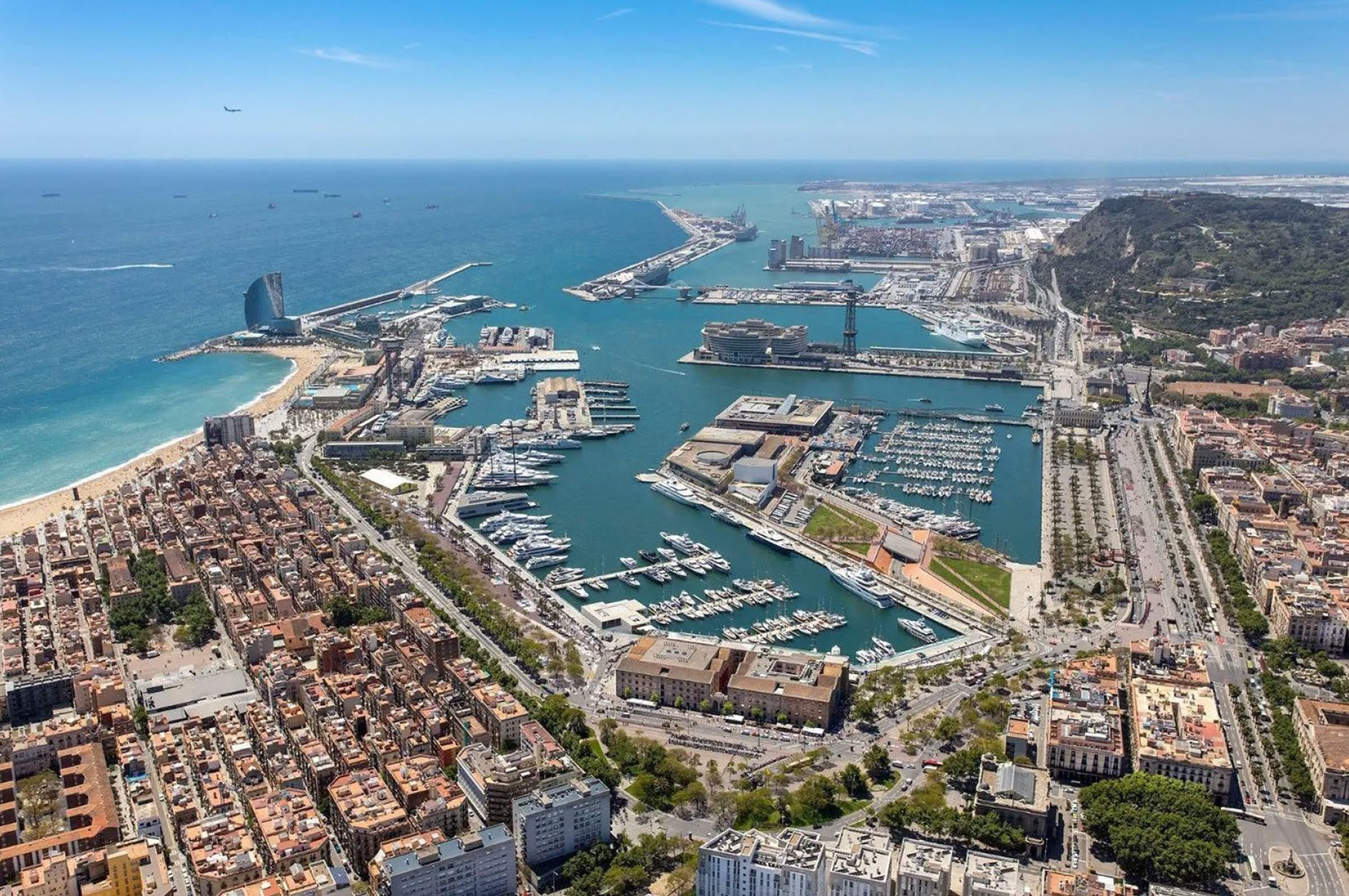
Port Vell de Barcelona. (© Port de Barcelona, 2022).
Port Vell de Barcelona. (© Port of Barcelona, 2022).
La preparación del evento
Event Preparation
Después de la adjudicación de la 37 edición de la Copa América de Vela a Barcelona en marzo de 2022, se iniciaron los trabajos necesarios para la preparación de este. A destacar:
- Constitución de la empresa ACE España: es la empresa organizadora del evento, propiedad del Team New Zealand, y que es la encargada de organizar y gestionar el evento. La primera de sus actuaciones fue la redacción del Máster Plan, como documento guía para preparar los grupos de trabajo a desarrollar conjuntamente entre el organizador y la ciudad ganadora (Host).
- Creación de la Fundación Barcelona Capital náutica. Entidad creada por el Host y que se aglutina en un Patronato a las administraciones públicas y empresarios privados que dieron apoyo económico inicialmente, y después colaboraron en la organización. Los miembros son:
El Gobierno de España, la Generalitat de Cataluña, Diputación de Barcelona, Cámara de Comercio, Ayuntamiento de Barcelona, Puerto de Barcelona, Turismo de Barcelona y Barcelona Global.
Dicha fundación se gestiona mediante un director que reporta a un Comité Ejecutivo, y la principal función es coordinar las aportaciones económicas del Host, la promoción del evento, la organización de la ceremonia de inauguración, el desarrollo de proyectos de sostenibilidad y la gestión del legado. - Constitución de diversos grupos de trabajo para el desarrollo, preparación, la coordinación, e implementación de aspectos clave como la seguridad, la movilidad, las operaciones terrestres y marítimas, etc.
After the 37th America’s Cup was awarded to Barcelona in March 2022, the necessary preparation work began. Highlights included:
- Establishment of ACE España: ACE España, the organizing company for the event, is owned by Team New Zealand and was responsible for organizing and managing the event. One of its first tasks was the creation of the Master Plan, a guiding document to prepare the working groups for collaboration between the organizer and the host city.
- Creation of the Barcelona Nautical Capital Foundation. This entity was created by the Host and is governed by a Board that includes public administrations and private companies that initially provided financial support and later collaborated on the event’s organization. Members include the Spanish Government, the Generalitat of Catalonia, the Barcelona Provincial Council, the Barcelona Chamber of Commerce, the City Council of Barcelona, the Port of Barcelona, Barcelona Tourism, and Barcelona Global. The foundation was managed by a director who reported to an Executive Committee. Its main function was to coordinate the Host’s financial contributions, promote the event, organize the opening ceremony, develop sustainability projects, and manage the legacy.
- Formation of Work Groups. Several working groups were formed to develop, prepare, coordinate, and implement key aspects such as security, mobility, and land and maritime operations.
A destacar la creación de la Oficina Copa América del Puerto de Barcelona, de la que el autor fue el responsable. Así también, la Oficina de coordinación de Copa América del Ayuntamiento de Barcelona, y los grupos de trabajo específicos en función del Máster Plan Preparado por ACE. Entre ellos los más activos y complejos fueron los de Seguridad, los de Operaciones en agua, y el de movilidad.
Notably, the creation of the America’s Cup Office at the Port of Barcelona, led by the author, and the America’s Cup Coordination Office at the City of Barcelona, along with specialized working groups based on the Master Plan prepared by ACE. Among the most active and complex were Security, Water Operations, and Mobility groups.
El Máster Plan
The Master Plan
En el mes de Julio del 2022, el organizador presentó el Máster Plan, que era el Plan de desarrollo del evento. En él se incluyeron los siguientes aspectos:
- Gobernanza de ACE: Organigrama y Áreas funcionales
- Gobernanza del Host
- Elementos clave a desarrollar (Key Hubs Operational Events)
- Procedimientos por desarrollar
- Layout de los diferentes espacios del Evento
- Presupuesto
- Calendario
In July 2022, the organizer presented the Master Plan, a development plan for the event, which included the following aspects:
- Governance: Organizational chart and functional areas
- Host Governance
- Key Elements to Develop (Key Hubs Operational Events)
- Procedures to Develop
- Layout of the Event’s Spaces
- Budget
- Schedule
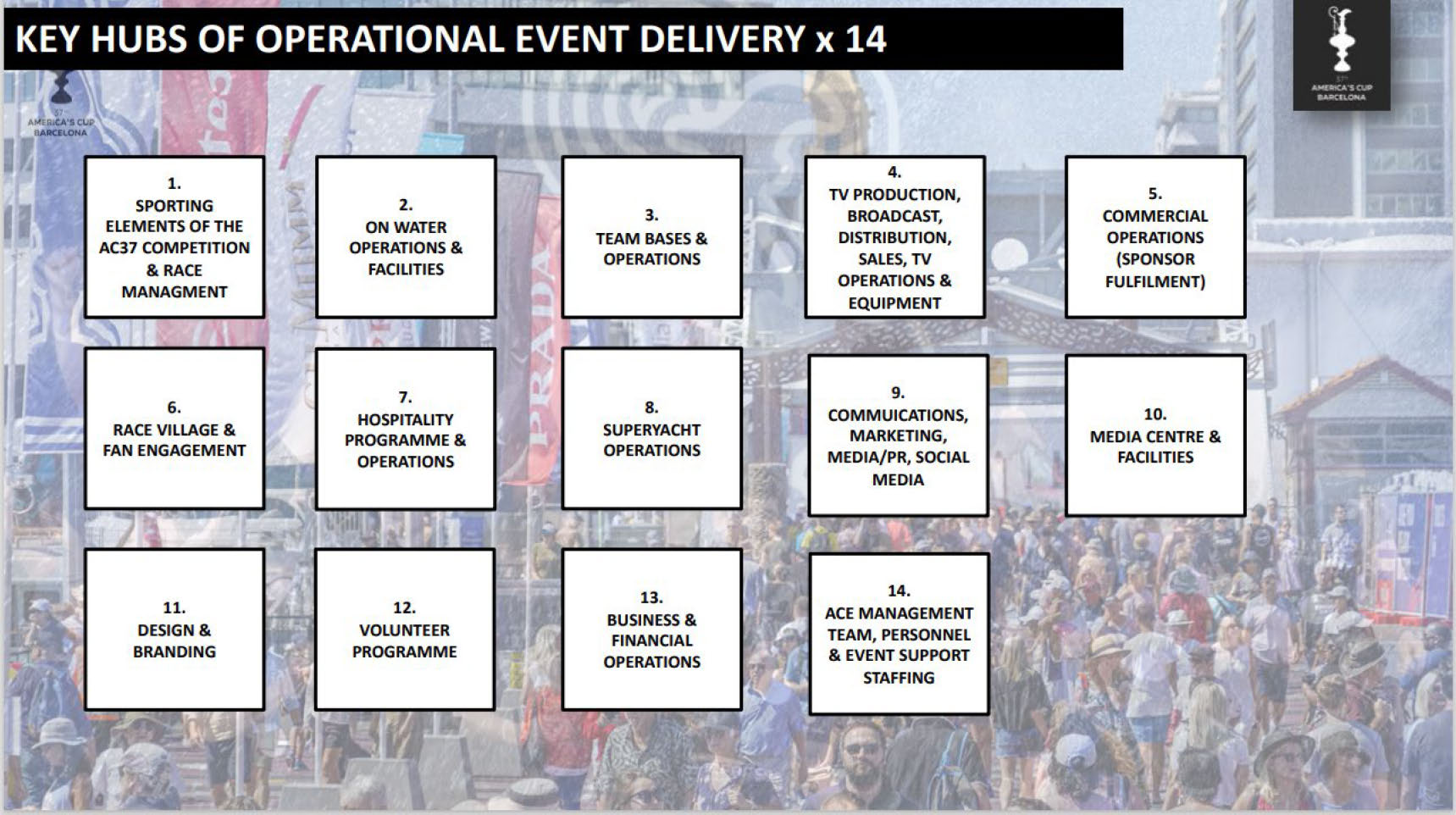
Key hubs of operational event delivery. (© ACE37, 2022).
Key hubs of operational event delivery. (© ACE37, 2022).
El rol del Puerto. Funciones de OCA (Oficina de la Copa América) del Puert
The Role of the Port: Functions of the Port’s OCA (America’s Cup Office)
La organización de la Copa América en el Puerto y en el Port Vell fue pilotada desde la Oficina de coordinación de la Copa América (OCA), como herramienta de coordinación de todos los Departamentos de la Autoridad Portuaria de Barcelona y como interlocutor único con ACE y resto de administraciones o empresas implicadas, y conjuntamente con la Gerencia urbanística Port Vell. Dicha transformación implicaba los siguientes retos:
Preparar los espacios necesarios para las bases de los equipos
La 37edicion de la Copa América, requería la habilitación de los espacios para los 6 equipos que debían participar en la competición. La Copa América se distingue de otras competiciones, en el que los equipos se instalan durante largo tiempo en el Puerto del evento. En esta ocasión el compromiso del Puerto fue entregar los terrenos en febrero de 2023 a todos los equipos, para que posteriormente cada uno construyera su respectiva base con las instalaciones de agua y de tierra adecuadas.
Fue un reto mayúsculo por el corto espacio de tiempo, la necesidad de modificar/alterar hasta 21 contratos de concesión vigentes, y las incertidumbres en conocer los requerimientos técnicos de los equipos para sus bases.
Por ello y para garantizar el cumplimiento de las normativas constructivas de España, Cataluña y de Barcelona, la OCA desarrolló una guía técnica para el desarrollo del Proyecto de las Bases (Julio 2022), de obligado cumplimiento para los Proyectos de los todos los Equipos.
Dicha guía favoreció la presentación de Proyectos homogéneos, con el correcto cumplimiento de los estándares de construcción, y la obligación de implementación de medidas ambientales. En paralelo Ayuntamiento y Puerto crearon un grupo de Trabajo para la revisión, tramitación y aprobación conjunta de dichos proyectos, que facilitó su conformidad en el mes de febrero de 2023, para el inicio posterior de las obras. Ello permitió que desde febrero de 2023 hasta junio del 2023 los equipos construyeran las bases y en verano del 2023 estuvieran todos entrenando en aguas de Barcelona, un año antes del evento.
The organization of the America’s Cup at the Port and Port Vell was managed from the America’s Cup Coordination Office (OCA), serving as a coordination point for all the departments of the Port Authority of Barcelona. The OCA also acted as the main liaison with ACE and other related administrations or companies, working in close collaboration with the Port Vell Urban Management. This transformation involved several challenges:
Preparing Spaces for Team Bases
The 37th edition of the America’s Cup required the preparation of spaces for the six teams participating in the competition. Unlike other competitions, teams set up long-term installations in the event’s harbor. In this case, the Port was committed to providing the land for the teams by February 2023, allowing each team to construct their respective base with the necessary land and water facilities.
This was a major challenge due to the short timeframe, the need to modify or alter 21 existing concession contracts, and the uncertainties surrounding the technical requirements of the teams for their bases.
To ensure compliance with the construction regulations of Spain, Catalonia, and Barcelona, the OCA developed a technical guide for the Base Project (July 2022), which all teams had to follow.
This guide helped ensure uniform project submissions, proper adherence to construction standards, and the implementation of environmental measures. Meanwhile, the City Council and Port Authority created a working group to jointly review, process, and approve these projects, facilitating their approval in February 2023. This allowed the teams to begin construction in February 2023, and by the summer of 2023, all teams were already training in Barcelona’s waters, a full year before the event was due to start.
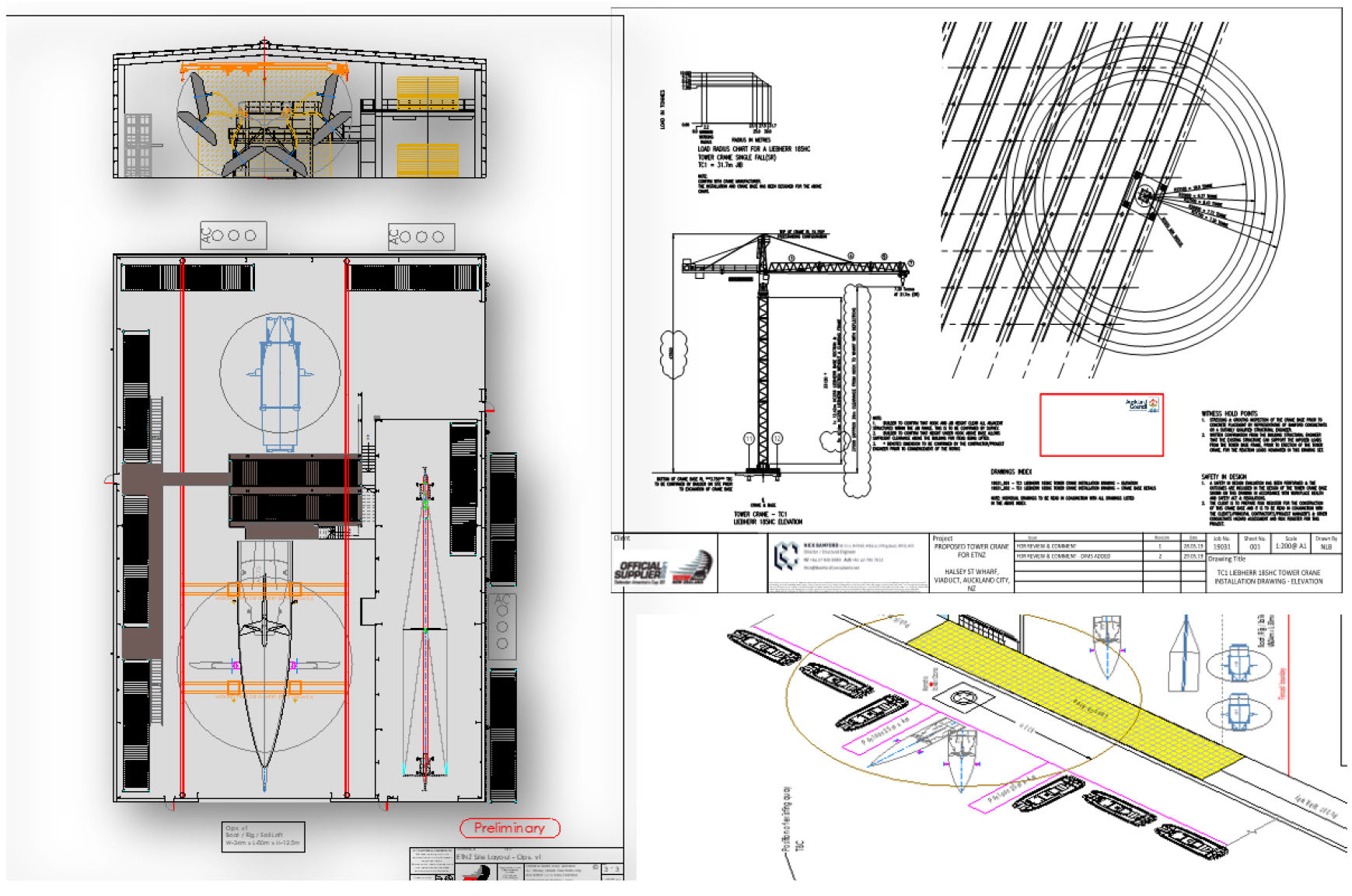
Base tipo Copa América, con zona tierra, agua y grúa torre. (© Team New Zealand, 2022).
America’s Cup Base Type, with land, water, and tower crane areas. (© Team New Zealand, 2022).
El Puerto desarrolló y creó los espacios de cada una de las Bases, desde junio de 2022 hasta febrero 2023, con numerosas y frenéticas negociaciones, con modificaciones de contratos de concesionarios, y la ejecución del compromiso de entrega del terreno a cada uno de los equipos.
Dichos requerimientos implicaban diversas obras tal como demoliciones de edificios, modificaciones de espacios, pavimentaciones, traslado de actividades, etc. con el fin de entregar en fecha una superficie de tierra de entre unos 3000 a 4000 m2, con servicios de agua, luz, alcantarillado, fibra óptica, y pendiente plana. Esas superficies debían tener acceso a un muelle para la instalación de los pantalanes para las embarcaciones, y conexión con un vial para el traslado de todos los elementos necesarios para los equipos.
Otro de los retos fue desarrollar y autorizar la mejor implantación de las cimentaciones para las grúas torre de unos 45 metros de altura junto al agua, para mover diariamente los barcos. Dichas cimentaciones alcanzaban dimensiones de 3 metros de ancho, 3 metros de largo y hasta 2 metros de alto, con un peso estimado de unas 50 toneladas y cargas superiores a 5 toneladas por metro cuadrado, y en muelles de bloques antiguos, de escasa capacidad portante. Fue necesario la ejecución de cimentaciones profundas en algunos casos.
Sin duda la creación de la OCA, juntamente con la redacción de una guía para estandarización de los documentos y procesos para implementar las bases, y junto la creación del grupo de trabajo de Bases con el Ayuntamiento, han sido las razones clave para la eficiente, ágil y rápida implantación de los 6 equipos.
The Port developed and created the spaces for each team’s base from June 2022 to February 2023, involving numerous and intensive negotiations, modifications to concession contracts, and the execution of the commitment to deliver the land to the teams.
These requirements involved various construction projects such as building demolitions, space modifications, paving, and the relocation of activities to provide land areas of 3,000 to 4,000 m² with essential services like water, electricity, sewage, fiber optics, and a level surface. These spaces also needed access to a dock for the installation of piers for the boats and direct access to roads for transporting the necessary equipment.
Another challenge was developing and authorizing the best foundation designs for the 45-meter high tower cranes next to the water, which would be used to move the boats daily. The foundations measured 3 meters wide, 3 meters long, and up to 2 meters high, with an estimated weight of 50 tons and loads of more than 5 tons per square meter, all on old docks with limited load-bearing capacity. In some cases, deep foundations had to be executed.
Undoubtedly, the creation of the OCA, the drafting of a standardization guide for documents and processes, and the establishment of the Base working group with the City Council were key factors in the efficient, swift, and smooth implementation of the six team bases.

Base equipo Defender Team New Zealand. (© Oficina Copa América Port de Barcelona, 2023).
Base of Defenders, Team New Zealand. (© America’s Cup Office, Port of Barcelona, 2023).
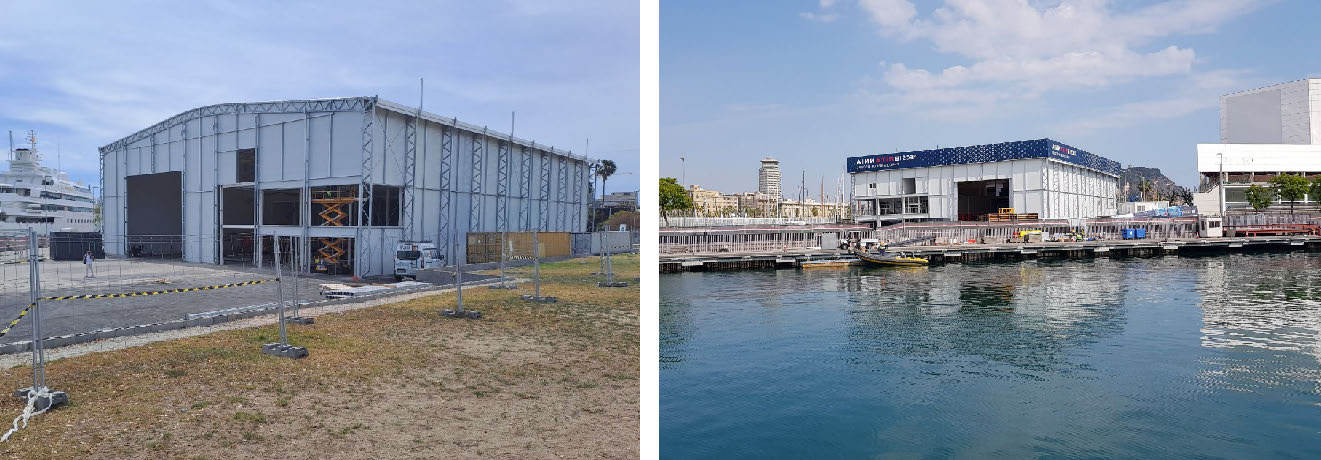
Base equipo Uk Inneos. (© Oficina Copa América Port de Barcelona, 2023).
Base of the UK Team INEOS. (© America’s Cup Office, Port of Barcelona, 2023).

Base equipo USA American Magic. (© Oficina Copa América Port de Barcelona, 2023).
Base of Team USA American Magic. (© America’s Cup Office, Port of Barcelona, 2023).

Base equipo Italia Luna Rossa Prada Pirelli. (© Oficina Copa América Port de Barcelona, 2023).
Base of Italy Luna Rossa Prada Pirelli. (© America’s Cup Office, Port of Barcelona, 2023).
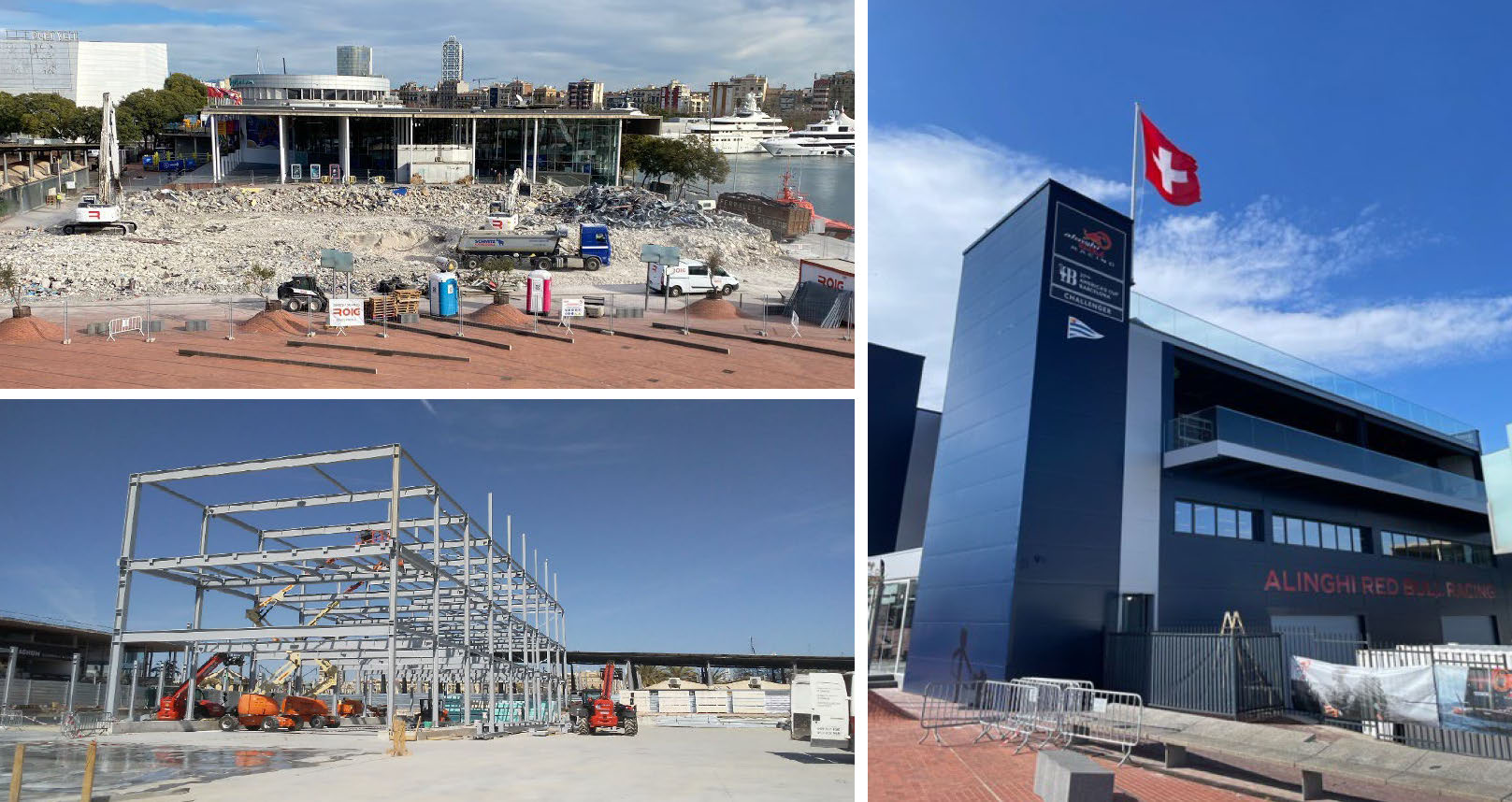
Base equipo Suiza Allinghi Red Bull. (© Oficina Copa América Port de Barcelona, 2023).
Base of Swiss team Red Bull. (© America’s Cup Office, Port of Barcelona, 2023).

Base equipo Orient Express Racing. (© Oficina Copa América Port de Barcelona, 2023).
Base of Orient Express Racing. (© America’s Cup Office, Port of Barcelona, 2023).
Preparar los espacios logísticos, operativos del evento
Para el desarrollo del evento era necesario implementar dentro del Port Vell los espacios para su adecuada organización. Hay que destacar los siguientes:
CECOR. Centro de Coordinación
Para la adecuada coordinación de las labores de Seguridad, Salvamento, y la gestión de las operaciones marítimas Portuarias, se construyó un centro de operaciones integral (CECOR) con las 3 áreas diferenciadas.
El Plan de Seguridad fue desarrollado por los Mossos d’Esquadra como policía de Catalunya y en colaboración de la policía Portuaria, la Guardia Civil, policía Nacional y Guardia Urbana de Barcelona. Se preveía la participación de unos 500 agentes en espacios de tierra, agua y espacio aéreo.
La coordinación de las aguas exteriores recayó en la Capitanía marítima de Barcelona en coordinación con el organizador ACE y resto de administraciones y operadores implicados en agua. La gestión de las aguas interiores recayó en la Autoridad Portuaria de Barcelona.
Uno de los mayores retos fue dimensionar, preparar y organizar la gestión del tráfico marítimo de la bocana norte del Puerto de Barcelona, que da acceso al Port Vell. Por ello se implementó una nueva Torre de control con gestión diferenciada de la Torre del resto del Puerto Comercial, que se denominó AC-Port Control. Fue necesario establecer simulaciones y finalmente normativas y regulaciones para una adecuada gestión del tráfico marítimo de acceso y salida al Port Vell, motivado por el gran volumen de Superyates que se preveía, su necesidad de practicaje en algunos casos, la coordinación con la salida de los Equipos, las embarcaciones de aficionados, de charters, las embarcaciones de Pesca, los ferris de servicio regular con preferencia de entrada y salida, algunos cruceros, y demás necesidades. Se implementó medidas de inteligencia artificial con cámaras en real en la Bocana Norte para conocer en todo momento la tipología, distribución, previsión del tráfico marítimo. Se llegaron a registrar más de 550 movimientos día, superando las condiciones habituales en más de 10 veces.
Preparar los espacios logísticos, operativos del evento
Para el desarrollo del evento era necesario implementar dentro del Port Vell los espacios para su adecuada organización. Hay que destacar los siguientes:
CECOR. Coordination Center
To ensure the proper coordination of security, rescue, and port maritime operations, a comprehensive operations center (CECOR) was constructed with three distinct areas.
The Security Plan was developed by the Mossos d’Esquadra (the Catalonian Police Force) in collaboration with the Port Police, the Civil Guard, the National Police, and the Barcelona Municipal Police Force. Around 500 agents were expected to be deployed on or in land, water, and air spaces.
The coordination of external waters was assigned to the Barcelona Maritime Captaincy in collaboration with ACE and other vested administrations and water operators. The management of internal waters was assigned to the Port Authority of Barcelona.
One of the greatest challenges was sizing, preparing, and organizing the management of maritime traffic in the northern entrance of the Port of Barcelona, which provides access to the Port Vell. For this reason, a new control tower was created, with separate management from the main Port Commercial Tower, and it was named AC-Port Control. It was necessary to establish simulations and, ultimately, regulations for proper management of the maritime traffic entering and exiting the Port Vell. This was driven by the large volume of superyachts expected, their need for pilotage in some cases, coordination with the departure of the teams, boats from spectators, charters, fishing boats, regular service ferries with entry and exit priority, some cruise ships, and other needs. Artificial intelligence measures were implemented with real-time cameras in the northern entrance to monitor the type, distribution, and forecast of maritime traffic at all times. More than 550 movements per day were recorded, exceeding normal conditions by more than 10 times over.
Procedimiento de Comunicaciones en agua y CECOR zona safety. (© Oficina Copa América Port de Barcelona, 2024).
Communication Procedures in Water and Safety Zone in CECOR. (© America’s Cup Office, Port of Barcelona, 2024).
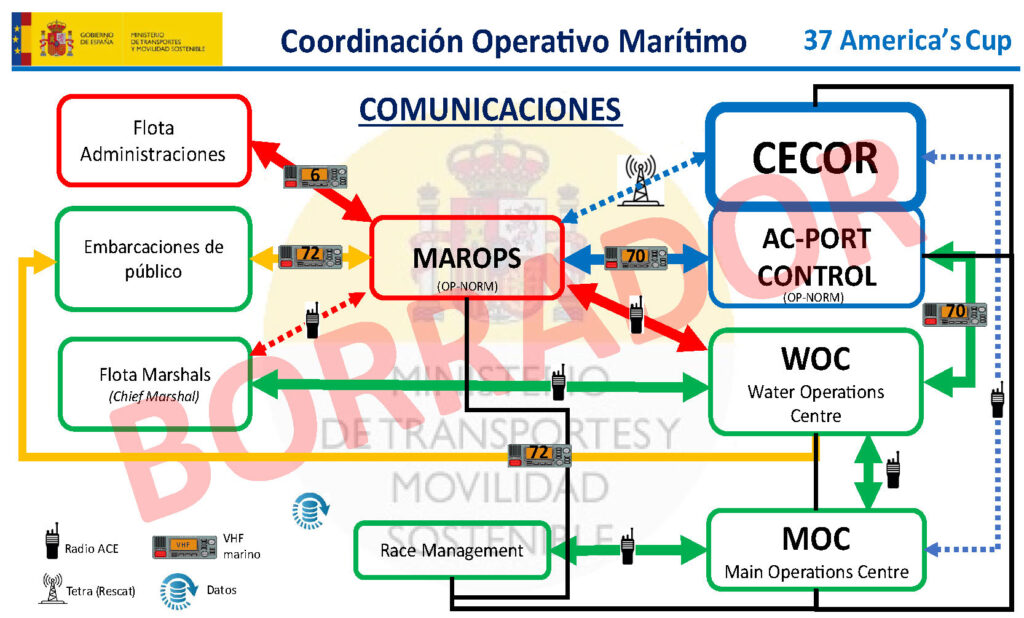
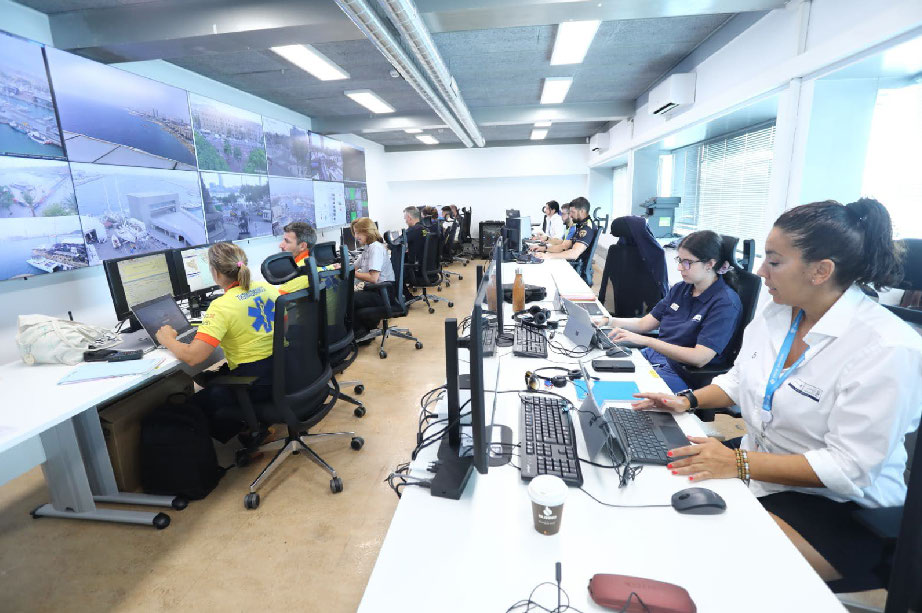
Las Marinas
Se procedió a instalar una serie de pantalanes para albergar diferentes marinas o espacios de amarre de embarcaciones al servicio del evento.
Marina ACE, la marina para las embarcaciones propias del organizador (árbitros, Jury, Marshal, TV, periodistas) con capacidad para unas 50 embarcaciones.
Aneja al CECOR se instaló la marina de seguridad y salvamento, una marina para unas 20 embarcaciones de policía marítima, de los Mossos Esquadra, Guardia Civil del Mar, Salvamento Marítimo.
The Marinas
Several piers and marinas were installed to accommodate various vessels for the event.
Marina ACE: Reserved for the organizer’s boats (referees, jury, marshal, TV, journalists), with space for up to 50 vessels.
Additionally, next to CECOR, a security and rescue marina was set up for 20 maritime police boats from Mossos d’Esquadra (Catalan Police), the maritime Civil Guard and Maritime Rescue services.
Proyecto para marina ACE y su implantación. (© Oficina Copa América Port de Barcelona, 2024).
ACE Marina Project and its Implementation. (© America’s Cup Office, Port of Barcelona, 2024).
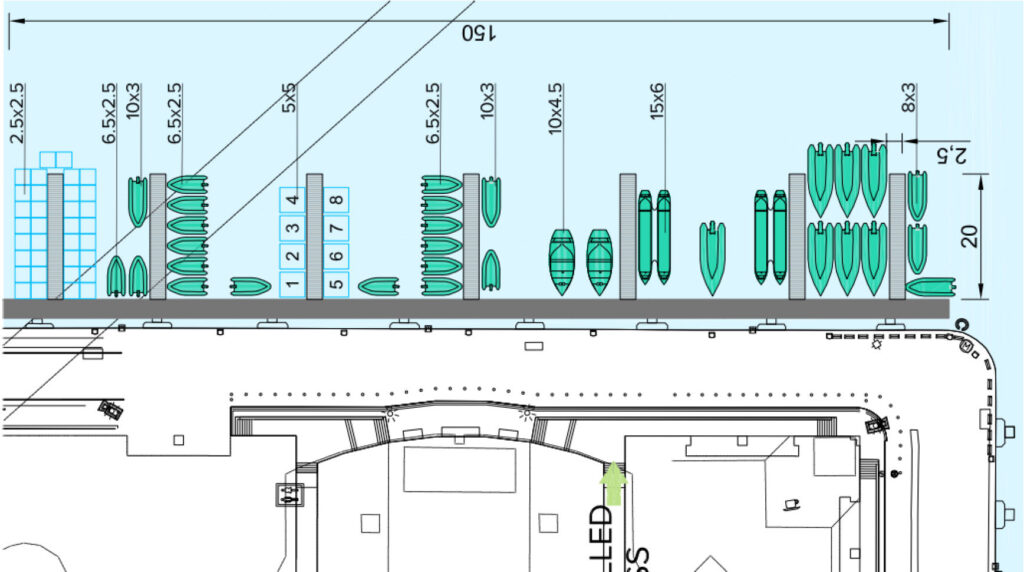
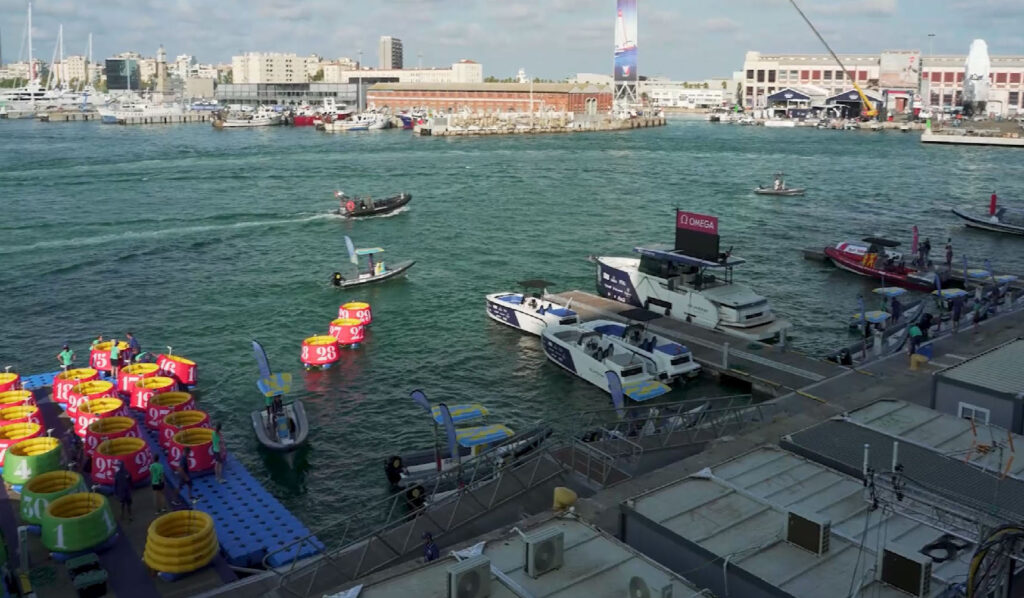
World Trade Center
El World Trade Center del Port de Barcelona fue el corazón del organizador ACE. Se instalaron los espacios de sus oficinas, el Centro de acreditaciones, La Sala de Prensa con capacidad para 250 periodistas, el centro logístico de la Televisión, Maritime Operations Center de ACE (MOC), el Main Operation Center de ACE (MOC), el Auditorio para las presentaciones y convocatorias. En el momento máximo del evento se llegaron a emplear más de 3500 m2 en diversas estancias del complejo.
Agrupar a todos los participantes en el evento fue un gran acierto, ya que se generaba una fácil y rápida interacción de todos los distintos Departamentos y áreas de la organización, y con la Marina de embarcaciones ubicada en el mismo muelle del World Trade Center, y el espacio de Voluntarios apenas a 100 m.
Centro de Voluntarios
En el edificio de la antigua estación norte de cruceros, el Puerto de Barcelona cedió los espacios para que se estableciera el Centro de Voluntarios. ACE preparó los espacios para atender a los aproximadamente 3.000 voluntarios que participaron en la 37ª Copa América. Se habilitó espacios de trabajo, de reunión, almacenes y zonas logísticas, y un comedor. Se utilizaron unos 2.500 m2 aproximadamente, con gran satisfacción por el organizador.
Race Village
Con el fin de conseguir dar difusión del evento a la máxima población posible, bajo el eje de la sostenibilidad social y la apuesta de Barcelona de hacer la edición de Copa América más abierta e inclusiva, el Puerto de Barcelona cedió el espacio del Moll de la Fusta del Port Vell los más de 60 días del evento.
El acceso fue libre y gratuito, con una superficie aproximada de 21.000 m2, a pie de Ramblas y bien conectado con transporte público. Se implementó el Escenario para todos los actos del evento, pantallas para visualizar la regata, así como stands de los patrocinadores y Host, restauración, y áreas de activación.
Fue el gran escaparate del evento, lleno de actividades, conciertos, presentaciones y celebración de todas las ceremonias de la regata, tal como la entrega de premios de todos los trofeos.
World Trade Center
The World Trade Center at Port de Barcelona became the heart of ACE’s operations. The space housed various facilities, including ACE’s offices, accreditation center, a press room for 250 journalists, the TV logistics center, the Maritime Operations Center (MOC), the Main Operations Center (MOC), and the auditorium for presentations. At the peak of the event, over 3,500 m² of the complex were occupied.
Bringing all event participants together in one location proved highly effective, as it facilitated quick interactions across departments and organizational areas. The proximity of the marina and volunteer area (located just 100 meters away) further streamlined operations.
Volunteer Center
In the building of the former northern cruise terminal, the Port of Barcelona provided space for the Volunteer Center. ACE organized the area to accommodate approximately 3,000 volunteers for the 37th America’s Cup. The center included workspaces, meeting areas, storage, logistics, and a cafeteria. Around 2,500 m² were dedicated to this center, and it was highly appreciated by the organizer.
Race Village
To maximize public engagement and promote the event as an inclusive and socially sustainable experience, the Port of Barcelona offered the Moll de la Fusta space in Port Vell for over 60 days during the event.
The Race Village spanned approximately 21,000 m², located at the foot of the Ramblas and well-connected by public transport. Entry was free, and the space featured an event stage, large screens to view the races, sponsors stands, restaurants, and activation areas.
It became a vibrant hub for activities, concerts, presentations, and ceremonies such as the prize-giving for all the trophies.
Escenario de la 37ª AC en el Rase Village del Moll de la Fusta del Port Vell. (© Oficina Copa América Port de Barcelona, 2024).
A stage of the 37th AC in the Race Village at Moll de la Fusta in Port Vell. (© America’s Cup Office, Port of Barcelona, 2024).
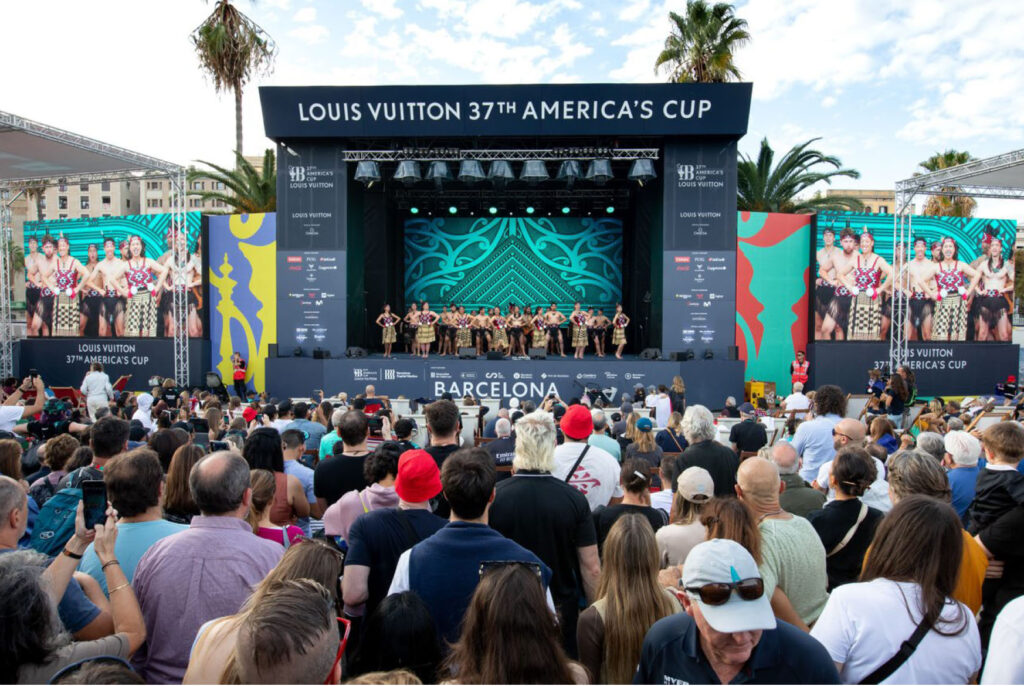
Otros espacios. Fun áreas, hidrolinera, espacios al servicio de la movilidad
Se implementó un área en la Plaza del Mar, con Pantalla grande y zonas de restauración, para mayor visibilidad de la Regata, por lo que hubo que dotarla de todos los equipamientos y espacios al servicio del visitante.
El Plan de movilidad generó un arduo y complejo trabajo, y fue necesario establecer una serie de hipótesis de visitantes, así como dimensionar los transportes públicos necesarios, y los espacios al servicio de una movilidad sostenible. El objetivo del Plan era favorecer y potenciar la movilidad a pie o en transporte público de los visitantes, y minimizar la afección a la vida de la ciudad y especialmente de los ciudadanos de los barrios portuarios del entorno. Se implantó la restricción de tráfico de coches privados en algunos momentos, a excepción de vecinos. Fue necesario disponer de nuevos espacios para bicicletas, motocicletas y buffers de taxis, que ayudaron a una movilidad eficiente. También se implementó un bus marítimo que conectaba la zona baja de las Rambla (Plaza Colón y Portal de la Pau) con el área de la nueva bocana.
En esta de Copa América se fomentó también la propulsión verde de las embarcaciones de apoyo de todos los equipos. Por una parte, se utilizaron numerosas embarcaciones con propulsión eléctrica, y se implementó también el uso de embarcaciones con el hidrogeno como combustible. Para poder proceder a la carga del hidrogeno, se instaló una hidrolinera. Se desarrolló fuera del puerto ciudad, en una zona segura, junto a la base del equipo francés.
Other Spaces. Leisure areas, hydrogen station, spaces serving mobility
An area was created in the Plaza del Mar, with a large screen and dining zones, to increase the visibility of the Regatta. This required equipping the area with all the necessary facilities and spaces for the visitors.
The mobility plan involved arduous and complex work, requiring the establishment of visitor hypotheses, as well as determining the necessary public transport and spaces to support sustainable mobility. The aim of the plan was to promote and enhance walking or public transport for visitors while minimizing the impact on the life of the city, especially for the residents of the surrounding port neighborhoods. A restriction on private car traffic was implemented at certain times, except for residents. New spaces were needed for bicycles, motorcycles, and taxi ranks, which helped ensure efficient mobility. A maritime bus was also implemented to connect the lower part of the Rambla (Plaza Colón and Portal de la Pau) with the new entrance area.
During this America’s Cup, green propulsion for support boats of all teams was also encouraged. On one hand, numerous electric-powered boats were used, and similarly the use of hydrogen-powered boats was also implemented. To facilitate hydrogen refueling, a hydrogen station was installed. It was developed outside the city port, in a safe area, near the French team’s base.

Hidrolinera instalada en el Puerto de Barcelona durante la 37ª Copa América. (© Oficina Copa América Port de Barcelona, 2024).
Hydrogen station installed at the Port of Barcelona during the 37th America’s Cup. (© America’s Cup Office, Port of Barcelona, 2024).
La transformación del Port Vell
The Transformation of Port Vell
En paralelo a todos los trabajos estrictamente necesarios a la preparación del evento, que hemos explicado anteriormente, el Puerto de Barcelona aprovechó las circunstancias para impulsar hasta 24 proyectos de transformación y actualización del Port Vell, y que se ejecutaron con el fin de estar finalizados antes del agosto de 2024.
En las décadas de los ochenta y los noventa del siglo pasado la transformación del Port Vell de Barcelona fue un referente importante en los debates sobre reconversiones portuarias a nivel internacional. Era la primera (y continúa siendo la más importante) transformación de un espacio portuario a usos y actividades urbanas en el Mediterráneo e incluso, en aquella época, en toda la Europa continental. Solo las grandes operaciones del entorno del Pier 37 en San Francisco (1979), el Inner Harbour de Baltimore (1981) y los Docklands de Londres y Liverpool (1981), superaban en superficie y se habían iniciado pocos años antes que la reconversión urbanística de Barcelona. Esta última había comenzado en el moll de la Fusta (muelle de la Madera) con un proyecto de Manuel Solá-Morales (1983) y el Plan Especial del Port Vell elaborado por el propio puerto (1989).
El Port Vell continúa siendo un área urbano-portuaria importante y atesora una importante experiencia de planificación, de relación pública-privada, de captación de inversiones, de gestión del mantenimiento, de relaciones puerto-ciudad y de gobernanza. Más de treinta años después de las primeras transformaciones, era necesario una actualización de algunas áreas e impulso de nuevas. La Copa América era la excusa perfecta para ejercer el efecto catalizador necesario para el desarrollo de numerosos proyectos que estaban pendientes, o en cartera.
In parallel with the essential preparations for the event mentioned earlier, the Port of Barcelona took the opportunity to push forward 24 transformation and upgrade projects within Port Vell, with the goal of completing them by August 2024.
During the 1980s and 1990s, the transformation of Port Vell in Barcelona became an important reference point in international debates about port reconversions. It was the first— and continues to be the most important— transformation of a port space into urban activities and uses in the Mediterranean, or even in continental Europe at the time. Only major operations like San Francisco’s Pier 37 (1979), Baltimore’s Inner Harbour (1981), and the Docklands in London and Liverpool (1981) surpassed its surface area, and they had begun just a few years before Barcelona’s urban renewal project. The transformation of Port Vell began at the Moll de la Fusta (Wood Dock) with a project by Manuel Solà Morales (1983) and the Special Plan for Port Vell, developed by the port itself (1989).
Port Vell remains a significant urban-port area and has a wealth of experience in planning, public-private partnerships, investment attraction, maintenance management, port-city relations, and governance. Over thirty years after the first transformations, some areas required updates, while new projects needed to be initiated. The America’s Cup presented the perfect opportunity to act as a catalyst for the development of numerous pending or planned projects.
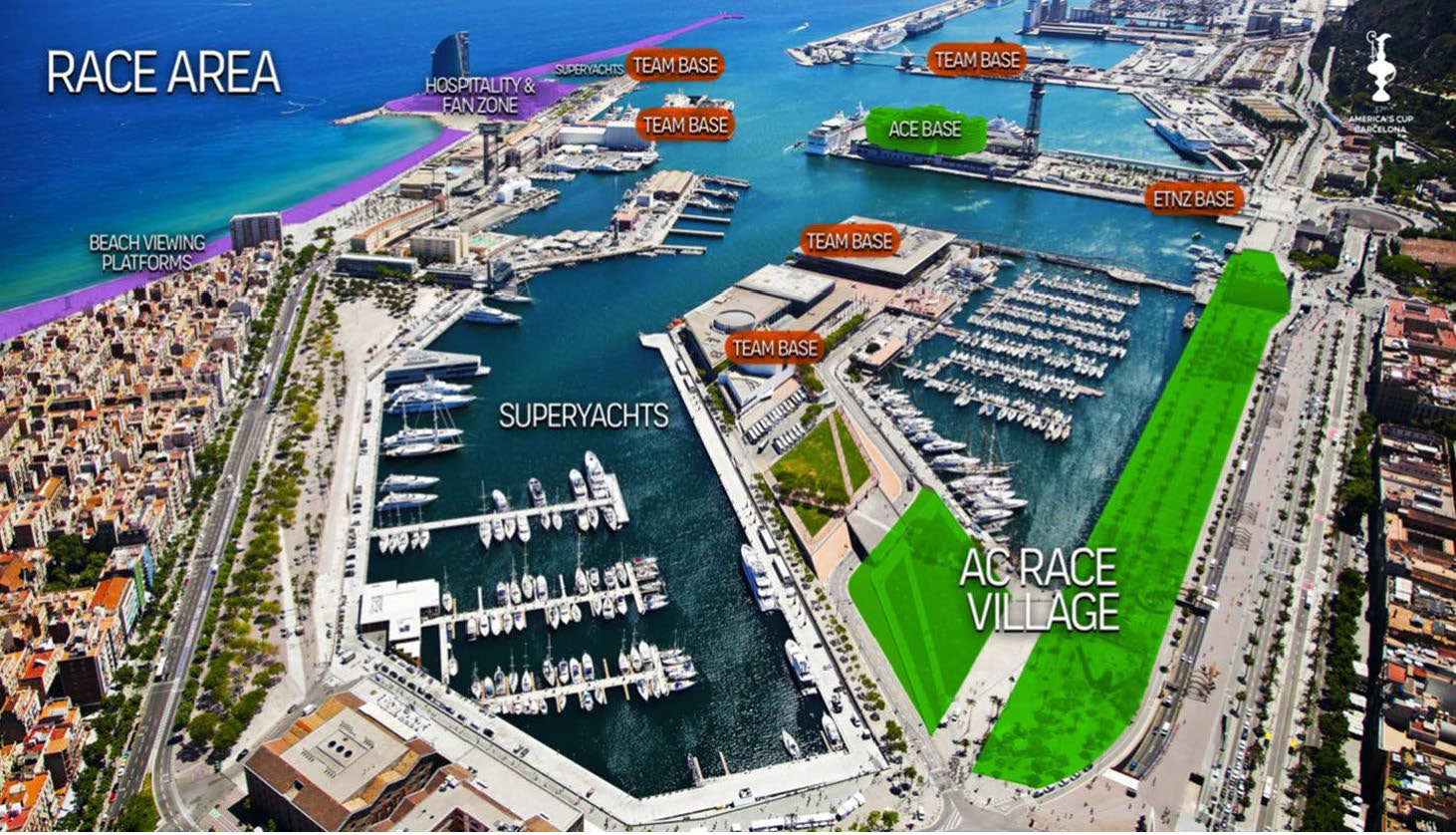
Los espacios del Port Vell destinados a la 37ª Copa América. (© Oficina Copa América Port de Barcelona, 2024).
Port Vell spaces dedicated to the 37th America’s Cup. (© America’s Cup Office, Port of Barcelona, 2024).
Entre el mes de junio de 2022 y el mes de julio de 2024, en el Port Vell se han ejecutado 139,5 millones de euros de inversión público-privada. Trece proyectos corresponden a la iniciativa pública del Puerto de Barcelona, ascendiendo a 52,1 millones de euros. Son proyectos muy importantes que han supuesto sin duda una renovación de un gran espacio de contacto y de relación puerto-ciudad. Pero quizás lo más relevante es el desarrollo de los 11 proyectos impulsados por la iniciativa privada, y que ascendieron a 87.4 millones de euros, y son la confirmación de la confianza del sector privado en el Port Vell, renovado, y preparado para afrontar los retos de futuro.
Between June 2022 and July 2024, the Port Vell area saw an investment of €139.5 million in public-private funding. Thirteen projects were publicly initiated by the Port of Barcelona, amounting to €52.1 million, including significant projects that contributed to the renewal of a major port-city contact and relationship space. What’s particularly notable are the 11 private sector-driven projects, which accounted for €87.4 million, demonstrating the private sector’s confidence in the renewed Port Vell, now ready for future challenges.
Desglose de proyectos
Breakdown of Projects
Los proyectos, reportados en el siguiente mapa, se pueden agrupar en las siguientes categorías:
Proyectos asociados a la mejoras de las Infraestructura o Edificaciones Portuarias
- Rehabilitación espaldón Nova Bocana (1)
- Espigón de Sant Sebastiá (2)
- Nuevos espacios para el Instituto de náutica (3)
- Reforma del Edificio histórico de Portal de la Pau (4)
Proyectos asociados a la ampliación de los espacios Puerto-Ciudad
- Urbanización del Moll de Drassanes (5)
- Remodelación Área Pesquera-Lonja (6)
Proyectos asociados a espacios o instalaciones para la Copa América
- Adecuación de los espacios del Barcelona Nàutic Center (7)
- Rehabilitación tinglados del Moll Oriental (8)
- Traslado de la operativa de Barcelona Nord a Adossat (9)
- Urbanización de las explanadas de la Nova Bocana (10)
- Demolición Cinesa (11)
- America’s Cup Experience – antiguo IMAX (12)
- Implementación de la red 5G (13)
- Mejoras en la fibra óptica (14)
- Inversiones tecnológicas en el CECOR (15)
- Bus Náutico (16)
Proyectos en la zona de la Nova Bocana
- Construcción de la Rambla del Rompeolas (17)
- Nuevo Edificio Mirador (18)
Proyectos de actualización y nuevos usos de concesionarios
- Transformación Marina Port Vell (19)
- Reforma espacios Club Natació Barcelona (20)
- Remodelación del Maremagnum (21)
- Reforma del Aquarium (22)
- Saneamiento de la Torre Jaume I (23)
- Remodelación del World Trade Center (24)
The projects, reported in the following map, can be grouped into the following categories:
Projects Related to the Improvement of Port Infrastructure or Buildings
- Rehabilitation of the Nova Bocana Bulkhead (1)
- Sant Sebastià Breakwater (2)
- New Spaces for the Nautical Institute (3)
- Portal de la Pau Renovation (4)
Projects Related to Expanding Port-City Spaces
- Urbanization of the Moll de Drassanes (5)
- Remodelling of the Fishing Area/Fish Market (6)
Projects associated with spaces or facilities for the America’s Cup
- Adaptation of Barcelona Nàutic Center spaces (7)
- Rehabilitation of the Eastern Dock sheds (8)
- Relocation of operations from Barcelona Nord to Adossat (9)
- Urbanization of the Nova Bocana Esplanades (10)
- Demolition of Cinesa (11)
- America’s Cup Experience – Former IMAX (12)
- Implementation of 5G network (13)
- Improvements in fiber optic infrastructure (14)
- Technological investments in CECOR (15)
- Nautical Bus (16)
Projects in the Nova Bocana Area
- Construction of the Breakwater Promenade (17)
- New Mirador Building (18)
Projects for Updating and New Uses of Concessions
- Transformation of Marina Port Vell (18)
- Renovation of Club Natació Barcelona facilities (19)
- Remodeling of the Maremagnum (20)
- Renovation of the Aquarium (21)
- Sanitation of the Torre Jaume I (22)
- Remodeling of the World Trade Center (24)
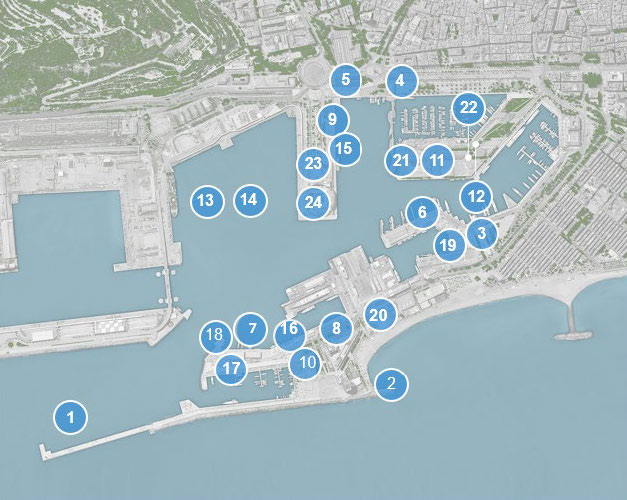
Proyectos transformación Copa América en el Port Vell. (© Gerencia Urbanística Port Vell, 2024).
America’s Cup Transformation Projects at Port Vell. (© Gerencia Urbanística Port Vell, 2024).
IMAGEN INICIAL | Salida final de la 37ª America’s Cup en el Port Vell. (© Oficina de Coordinación de la America’s Cup, Puerto de Barcelona, 2024).
HEAD IMAGE | Final departure of the 37th America’s Cup at Port Vell. (© America’s Cup Coordination Office, Port of Barcelona, 2024).